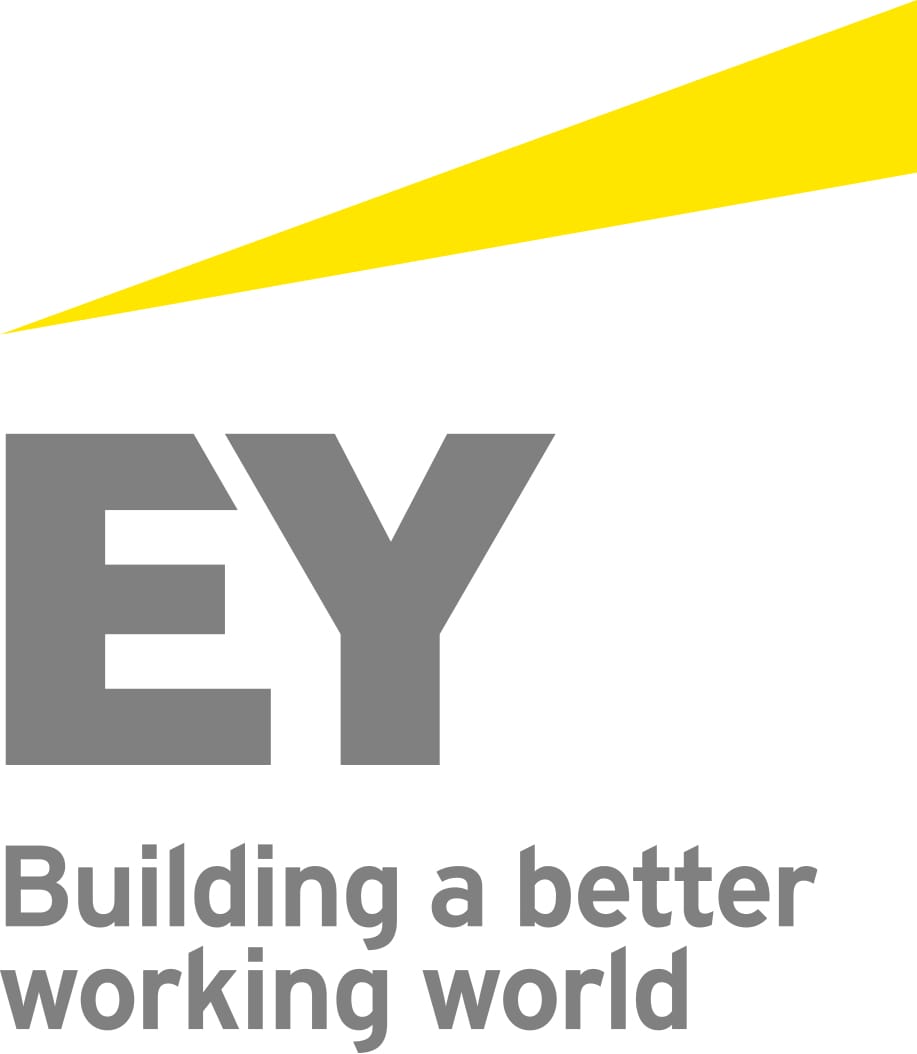APAC Executive Summary
Having examined the current state of women in the real estate and land use profession in the United States in 2016, the ULI Women’s Leadership Initiative (WLI) saw a need for continued exploration of this topic in other parts of the world. WLI, in partnership with EY, embarked on a journey to understand the state of women working in the industry in the Asia Pacific region (APAC).
Little information has been gathered about women in the real estate and land use field—and even less research has been conducted on this subject in APAC. The WLI and EY are uniquely positioned to explore this topic and, using ULI’s research knowledge and contacts, we were able to tap into the experiences of women in this profession and better understand their careers and professional opinions.
This research draws from a comprehensive survey of more than 280 female real estate and land use professionals primarily situated in the four major Asia Pacific countries of Australia, China, Hong Kong, and Singapore. These four countries were targeted because they have the largest concentration of women working in real estate in APAC. In addition to the survey, WLI conducted numerous one-on-one interviews with a diverse group of employees at one major real estate/land use organization in each of the aforementioned countries.
Key findings from the study include the following:
Women in Asia Pacific’s real estate and land use industry frequently change jobs to find success, though only half aspire to jobs in the C-suite or as a sole proprietor.
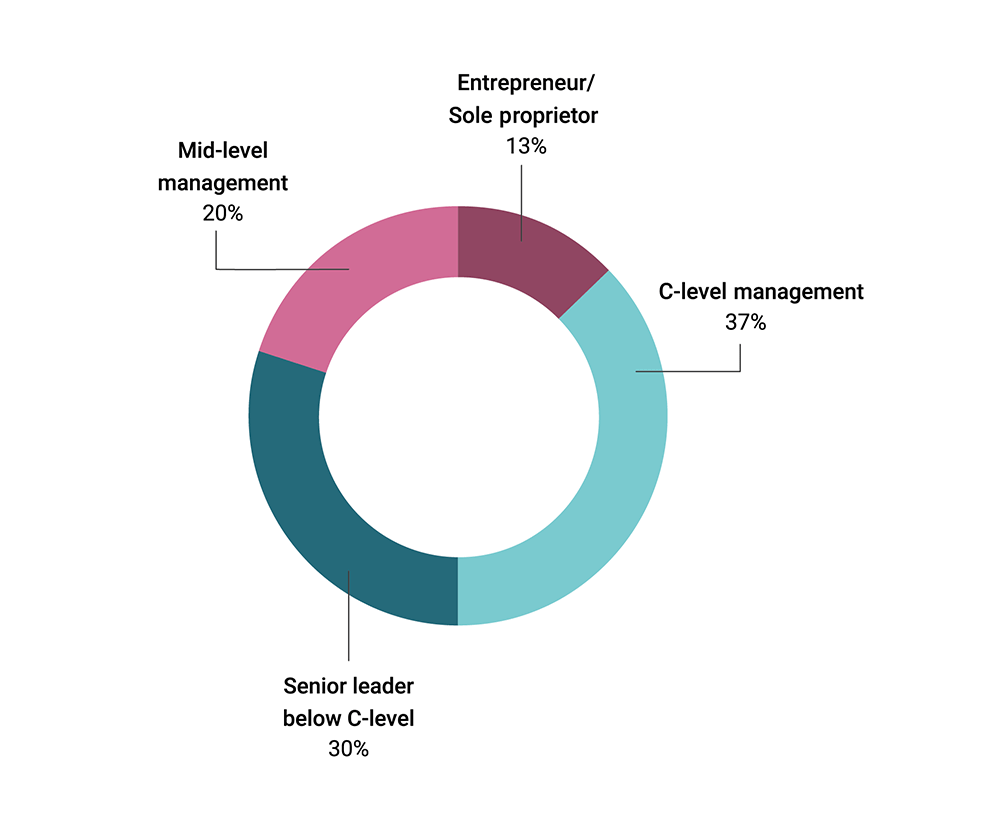 Forty-seven percent of survey respondents said they aspire to be C-level management or entrepreneurs/sole proprietors. Another 29 percent said they aspire to be senior-level leadership, below the C-suite, and 19 percent indicated they are aiming to serve as mid-level management. When broken out by country, the data reveal significant discrepancies as to the aspirations of women in different locations. In Singapore and Australia, 58 percent and 62 percent of survey respondents, respectively, are striving to be C-level management or entrepreneurs/sole proprietors. In Hong Kong, this number is 44 percent, with 30 percent focused on senior-level leadership positions and 20 percent aiming to work as mid-level management. In China, just 23 percent of respondents have their sights set on working in the C-suite or as an entrepreneur/sole proprietor; 34 percent aspire to be senior-level leadership; and 41 percent are working toward mid-level management positions. This broad intra-region variation in aspirations suggests that women’s aspirations and definitions of professional success may be tightly tied to country-specific influences, such as culture and societal norms and expectations. It could also be related to the prevalence of family-owned real estate businesses in parts of the region; these companies offer few C-suite spots, which may cause female employees to perceive that achieving this type of leadership position is unattainable.
Forty-seven percent of survey respondents said they aspire to be C-level management or entrepreneurs/sole proprietors. Another 29 percent said they aspire to be senior-level leadership, below the C-suite, and 19 percent indicated they are aiming to serve as mid-level management. When broken out by country, the data reveal significant discrepancies as to the aspirations of women in different locations. In Singapore and Australia, 58 percent and 62 percent of survey respondents, respectively, are striving to be C-level management or entrepreneurs/sole proprietors. In Hong Kong, this number is 44 percent, with 30 percent focused on senior-level leadership positions and 20 percent aiming to work as mid-level management. In China, just 23 percent of respondents have their sights set on working in the C-suite or as an entrepreneur/sole proprietor; 34 percent aspire to be senior-level leadership; and 41 percent are working toward mid-level management positions. This broad intra-region variation in aspirations suggests that women’s aspirations and definitions of professional success may be tightly tied to country-specific influences, such as culture and societal norms and expectations. It could also be related to the prevalence of family-owned real estate businesses in parts of the region; these companies offer few C-suite spots, which may cause female employees to perceive that achieving this type of leadership position is unattainable.
In addition, almost 75 percent of all respondents said they have been at their current employer for less than five years. Of this 75 percent, 60 percent indicated that they had more than six years of industry experience. This indicates that employer loyalty may not be particularly prevalent in this industry, and women may be willing to move to a new company in search of their version of professional success, better benefits, or other offerings that allow them to align their professional life with other factors that may be influencing them. However, in the real estate and land use industry within APAC, men too will change jobs frequently in order to move up the ladder, suggesting that this statistic is not unique to women in the industry.
Women need access to generous maternity/familial leave, as well as flexibility in their day-to-day schedules, in order to achieve success.
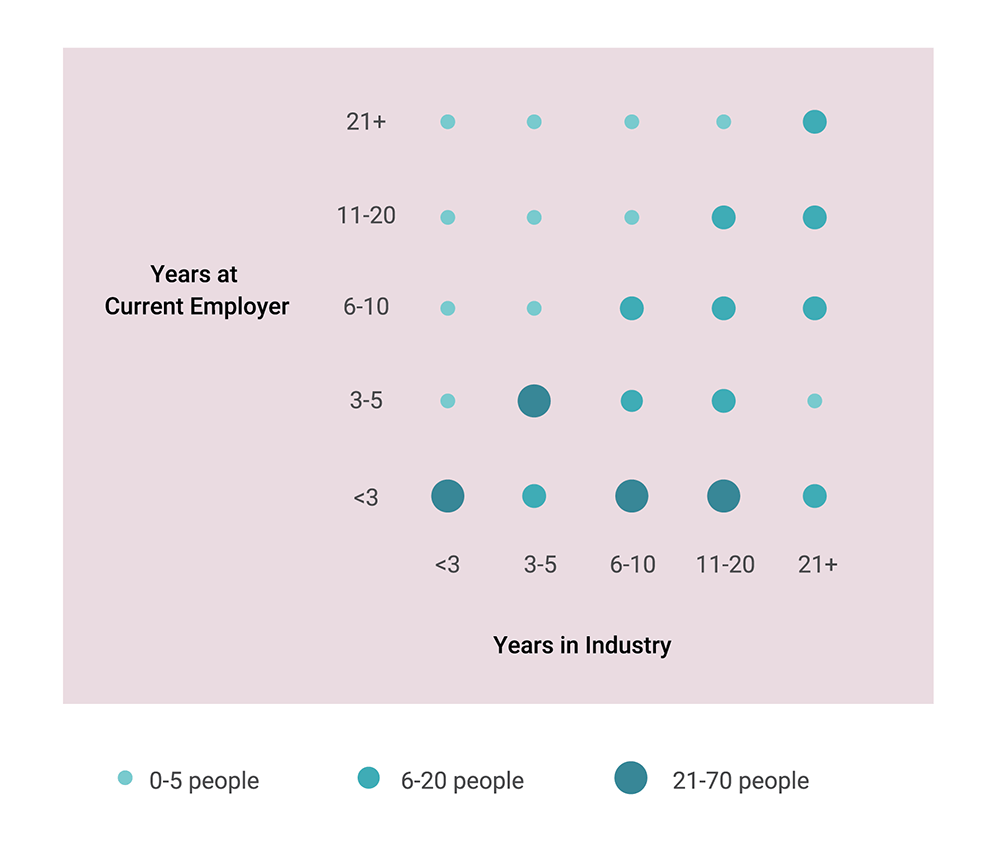 Fifty percent of all survey respondents indicated that being formally provided generous maternity/familial leave by their companies is critical to their career success and advancement. More than 50 percent of all survey respondents said that the ability to create flexibility in their day-to-day jobs (e.g., adjust work start/stop time) is also critical to their career success. These two offerings go hand-in-hand for many reasons, one of which is likely to be that parenting/familial activities do not stop once a female employee returns from maternity leave. Women seem to recognize that their long-term success depends on their companies’ policies supporting their ability to fulfill their familial commitments over time. In APAC, where it is still important at many companies to be seen sitting at your desk until the boss leaves, this type of day-to-day flexibility can be a new concept that requires employers to have a newfound elevated level of trust of their employees.
Fifty percent of all survey respondents indicated that being formally provided generous maternity/familial leave by their companies is critical to their career success and advancement. More than 50 percent of all survey respondents said that the ability to create flexibility in their day-to-day jobs (e.g., adjust work start/stop time) is also critical to their career success. These two offerings go hand-in-hand for many reasons, one of which is likely to be that parenting/familial activities do not stop once a female employee returns from maternity leave. Women seem to recognize that their long-term success depends on their companies’ policies supporting their ability to fulfill their familial commitments over time. In APAC, where it is still important at many companies to be seen sitting at your desk until the boss leaves, this type of day-to-day flexibility can be a new concept that requires employers to have a newfound elevated level of trust of their employees.
The third most important formal offering that a company can provide to support its female employees’ success is technical skills training and development programs. Overall, 45 percent of respondents indicated that these types of programs play a critical role in their ability to achieve success. In China, this percentage jumped to 66 percent of in-country respondents, which could be related to the importance that Chinese culture places on education.
Crucially, WLI found through its case studies that simply offering these programs is not necessarily enough to ensure their success; leadership must also support these programs and drive a strong “tone from the top.” In Australia, for example, interviews of employees at Mirvac revealed that the company had flexibility initiatives in place, but it wasn’t until senior-level management—and both men and women—started visibly promoting flexibility initiatives that they were broadly embraced across the company.
Informal support systems play a key role in women’s professional success and in fact may be more valuable to female employees than formal, company-sanctioned systems. Most important among these informal structures are internal (in-company) relationships, particularly with senior leaders, as well as an inclusive workplace culture.
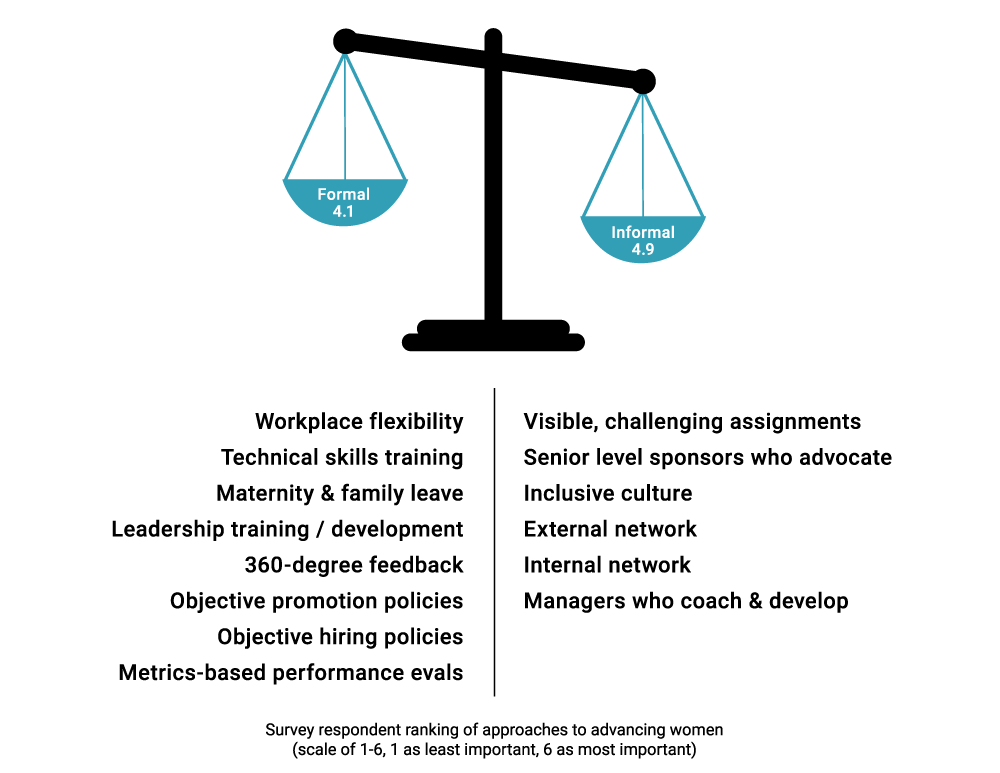 Overall, a higher percentage of survey respondents rated the informal support systems referenced in the survey as “extremely important” or “very important” than they did each of the formally organized programs. This indicates that, while formal, company-offered approaches are important to career success, women in the real estate and land use field may feel they can achieve a greater degree of success by engaging in less formal development approaches.
Overall, a higher percentage of survey respondents rated the informal support systems referenced in the survey as “extremely important” or “very important” than they did each of the formally organized programs. This indicates that, while formal, company-offered approaches are important to career success, women in the real estate and land use field may feel they can achieve a greater degree of success by engaging in less formal development approaches.
Seventy-three percent of survey respondents said that having relationships inside their organization as well as finding senior-level sponsors within their organization who advocate for them are critical to their success. Seventy-three percent also indicated that an inclusive workplace culture is key.
In WLI’s case studies, individuals described workplace culture and workplace relationships as interconnected: one individual explained that her workplace’s inclusive culture made it possible for her to have an open dialogue with her supervisor about her need for flexibility. In turn, this openness helped strengthen her relationship with her supervisor, who became an advocate for her success. The data seem to further reflect the link between culture and relationships and the role they both play in female employees’ ability to achieve professional success.
Female employees are not receiving the support they need from their companies to achieve professional success.
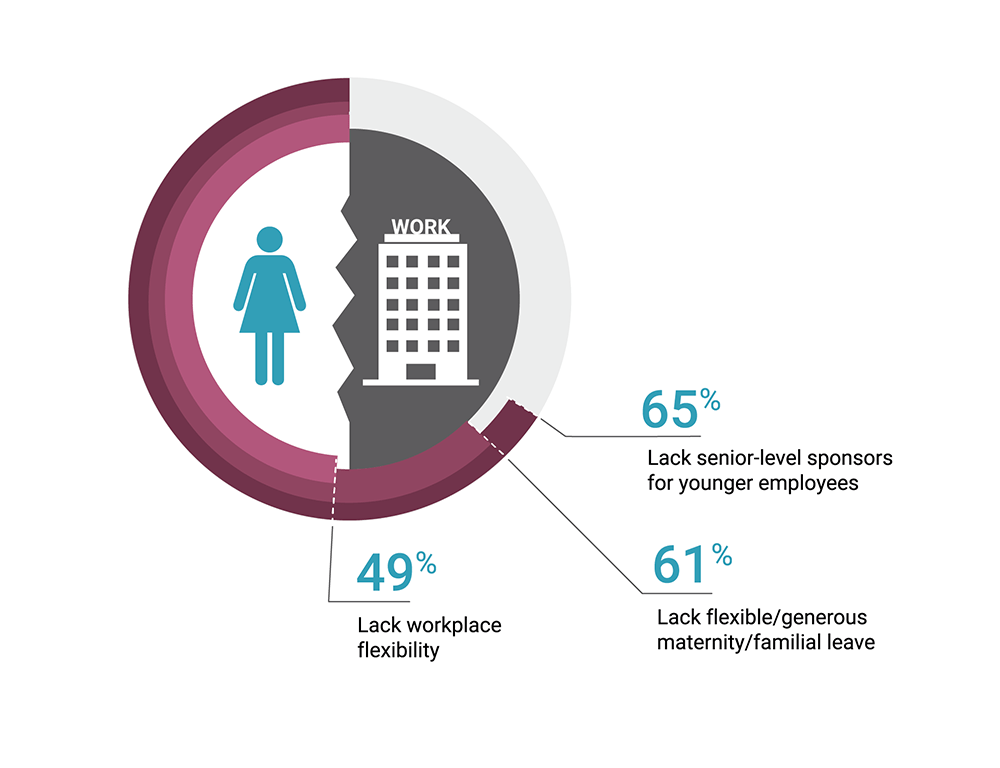 Despite the fact that 50 percent of survey respondents said that their ability to achieve success is heavily affected by their employers’ provision of day-to-day workplace flexibility and/or generous or flexible maternity/familial leave to be successful, a large percentage of respondents indicated that they do not receive these benefits from their companies. Forty-nine percent of survey respondents said that their companies do not provide day-to-day workplace flexibility, and 61 percent of respondents said they do not receive flexible or generous maternity/familial leave from their companies. In Australia, female employees seem to be faring somewhat better in terms of the latter offering, with a slightly lower percentage of respondents (45 percent) indicating they work at companies that do not provide them with flexible or generous maternity/familial leave. However, in China, Hong Kong, and Singapore, 61 percent or more of respondents indicated that they do not receive this benefit from their companies. While offering generous or flexible maternity/familial leave can increase costs for companies, providing other types of workplace flexibility to employees is typically low to no cost—companies could explore implementing even simple flexibility options (e.g., more flexible workday start and/or end times) to help address this need expressed by female employees.
Despite the fact that 50 percent of survey respondents said that their ability to achieve success is heavily affected by their employers’ provision of day-to-day workplace flexibility and/or generous or flexible maternity/familial leave to be successful, a large percentage of respondents indicated that they do not receive these benefits from their companies. Forty-nine percent of survey respondents said that their companies do not provide day-to-day workplace flexibility, and 61 percent of respondents said they do not receive flexible or generous maternity/familial leave from their companies. In Australia, female employees seem to be faring somewhat better in terms of the latter offering, with a slightly lower percentage of respondents (45 percent) indicating they work at companies that do not provide them with flexible or generous maternity/familial leave. However, in China, Hong Kong, and Singapore, 61 percent or more of respondents indicated that they do not receive this benefit from their companies. While offering generous or flexible maternity/familial leave can increase costs for companies, providing other types of workplace flexibility to employees is typically low to no cost—companies could explore implementing even simple flexibility options (e.g., more flexible workday start and/or end times) to help address this need expressed by female employees.
In addition, 65 percent of respondents across the region stated that their companies do not provide structures that support their ability to find senior-level sponsors who advocate for them, suggesting that women in the real estate and land use industry may struggle to find career advocates. Singapore had the highest marks in this area, with 49 percent of respondents saying that their companies help them access senior-level sponsorship, leaving 51 percent of respondents who do not receive this type of support from their companies. The efforts of some Singaporean companies to help their female employees find senior-level sponsors was reflected in WLI’s case study in Singapore with Alpha Investment Partners, where individuals commented that their senior leaders take time to develop them as professionals. Nevertheless, this practice does not seem commonplace in the region. Given that 73 percent of respondents indicated that finding senior-level sponsors is critical to their ability to achieve professional success, the lack of infrastructure within APAC-based real estate and land use organizations to support the development of these relationships could be creating obstacles for women in the industry. Similar to offering different types of flexibility options, creating opportunities for more junior female professionals to build relationships with more senior professionals could be a cost-efficient option that companies can explore to address challenges their female employees may be experiencing in this area.
It is noteworthy that respondents based in Hong Kong felt that their employers are overall less likely than those in other countries in the region to provide the formal and informal structures that are critical to female employees’ professional success. This could be due to the fact that the real estate and land use industry in Hong Kong, more so than in the other three countries, is long-established, with a relatively limited number of organizations. This level of maturity may have resulted in a slowed pace of organizational change for companies in this country, as compared with the pace of change experienced by other, fast-growing economies in the region. One impact of this slowed pace of change could be that women’s employment in this industry in Hong Kong did not begin until recently and is still a relatively new concept. Alternatively, the sentiment expressed by Hong Kong–based survey respondents could be influenced by the fact that Hong Kong introduced employment legislation supporting equal rights for women many years ago, and the typical perception in the country is that nothing else needs to be done in this arena.
Furthermore, Hong Kong’s policies on maternity leave, which grant ten weeks’ maternity leave to women who have been employed under a continuous contract for at least 40 weeks and provide four-fifths pay during those ten weeks1, lag behind the International Labour Organization’s standards for maternity leave2.
Conflict with family commitments is seen as the main barrier to women’s ability to achieve success.
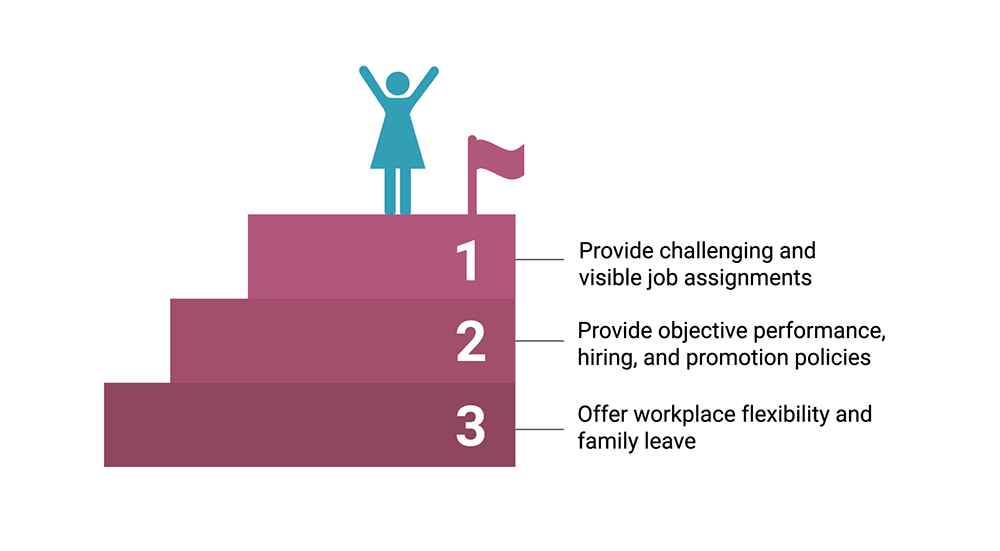 More than half of overall survey respondents indicated that the tension between workplace commitments and familial commitments, particularly those related to taking care of children, is the main barrier that prevents women from achieving professional success. Respondents in China and Hong Kong labeled this conflict as the number-one obstacle for women in the workplace. Hong Kong had the highest percentage of respondents (60 percent) that deemed conflict with family commitments to be the number-one barrier in their ability to achieve success. One potential driver of this heightened response rate could be that Hong Kong has a high proportion of long-established family-owned real estate companies that have not necessarily focused on or embraced conversations about flexibility or differentiated between the needs of their male and female employees. This could also be due to the same factors that potentially influenced Hong Kong–based respondents’ sentiments about the formal and informal structures their companies provide them. In Australia and Singapore, however, the percentage of women who indicated this as a main barrier was slightly lower (47 percent); challenges with corporate culture, organizational bias against women, lack of female role models, and a general lack of support from senior leadership rose to the top of the list for these countries’ respondents. This data could be indicative of certain cultural challenges that are currently at the forefront of Australian organizations’ dialogue. WLI learned through its case study in Australia that the country, via various government structures, such as the Workplace Gender Equality Agency (WGEA), is currently focused on enhancing organizations’ capabilities to foster inclusive cultures.
More than half of overall survey respondents indicated that the tension between workplace commitments and familial commitments, particularly those related to taking care of children, is the main barrier that prevents women from achieving professional success. Respondents in China and Hong Kong labeled this conflict as the number-one obstacle for women in the workplace. Hong Kong had the highest percentage of respondents (60 percent) that deemed conflict with family commitments to be the number-one barrier in their ability to achieve success. One potential driver of this heightened response rate could be that Hong Kong has a high proportion of long-established family-owned real estate companies that have not necessarily focused on or embraced conversations about flexibility or differentiated between the needs of their male and female employees. This could also be due to the same factors that potentially influenced Hong Kong–based respondents’ sentiments about the formal and informal structures their companies provide them. In Australia and Singapore, however, the percentage of women who indicated this as a main barrier was slightly lower (47 percent); challenges with corporate culture, organizational bias against women, lack of female role models, and a general lack of support from senior leadership rose to the top of the list for these countries’ respondents. This data could be indicative of certain cultural challenges that are currently at the forefront of Australian organizations’ dialogue. WLI learned through its case study in Australia that the country, via various government structures, such as the Workplace Gender Equality Agency (WGEA), is currently focused on enhancing organizations’ capabilities to foster inclusive cultures.
If companies have to choose where to put their resources when it comes to supporting female employees’ success, their top three priorities should be as follows: providing challenging job assignments, employing an objective performance review process, and offering flexibility.
 While 46 percent of respondents say that companies need to focus on offering workplace flexibility and maternity/familial leave, they also sent a strong message that this is not enough to ensure women’s success in the workplace. Fifty-six percent of respondents indicated that organizations should work to provide their female employees with challenging and visible job assignments as ways to support their success, and 50 percent of respondents said that companies should focus on developing and implementing objective performance evaluation, hiring, and promotion policies and practices.
While 46 percent of respondents say that companies need to focus on offering workplace flexibility and maternity/familial leave, they also sent a strong message that this is not enough to ensure women’s success in the workplace. Fifty-six percent of respondents indicated that organizations should work to provide their female employees with challenging and visible job assignments as ways to support their success, and 50 percent of respondents said that companies should focus on developing and implementing objective performance evaluation, hiring, and promotion policies and practices.
Although respondents had not previously indicated that visible and challenging job assignments were as critical to their success as certain other informal development offerings (i.e., internal relationships and inclusive workplace culture), 71 percent said that these types of assignments are at least “very important” to their success. Furthermore, respondents may see a connection between receiving visible and challenging job assignments and their ability to gain recognition with senior-level leaders who can become sponsors for them.
Objective performance management, hiring, and promotion policies were noted as some of the next most important formal elements required to achieve success. Respondents may have highlighted performance management, hiring, and promotion policies because they believe that companies can actually work to change these practices in a more tangible way than the issues related to raising a family.
Companies need to focus not just on bringing women into the industry, but also on keeping women employed long-term.
Despite the challenges facing women in the real estate and land use field in the region, and despite the opportunities that organizations have to provide more tools and programs to support their female employees’ success, 68 percent of survey respondents expect to see at least a slight—if not a significant—increase in the number of women in their organization. Australia was the most optimistic, with a quarter of in-country respondents expecting to see a significant increase. This ties with what WLI learned from its one-on-one interviews with Australian organization Mirvac about the focus that some Australian companies in the industry are placing not only on their female employees’ success, but also on hiring young women into real estate and land use organizations.
The real issue at hand regarding women’s presence in this industry, however, is not necessarily about the rate at which they join the industry, but rather about their ability to remain in the industry over time and achieve career longevity and success in the industry. ULI’s survey aimed to reach a representative sample of female professionals in the real estate and land use field. In examining the demographics of the sample, ULI found that the data collected primarily came from millennial/generation Y women (54 percent of respondents) and women who do not hold leadership positions at their organizations (74 percent of respondents). While these two data points could suggest that younger and/or less experienced professionals were more likely to respond to this survey, it is probable that these demographics are indicative of the overall make-up of women in the industry.
These demographics, coupled with the data showing that a high percentage women in the APAC industry do not aspire to reach leadership positions or to work as a sole proprietor, suggest that simply bringing more women into the industry may not enough to positively affect gender equality. Instead, companies should focus on fostering women’s career growth and providing incentives and support to continue working in the industry throughout all stages of their lives.


